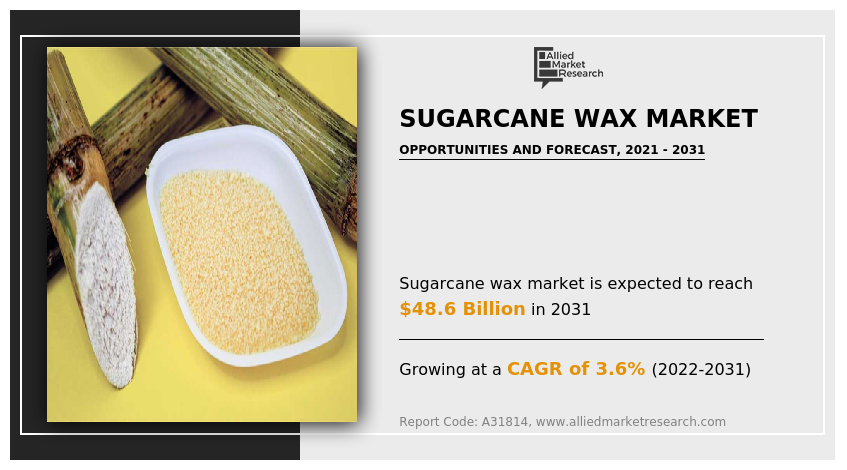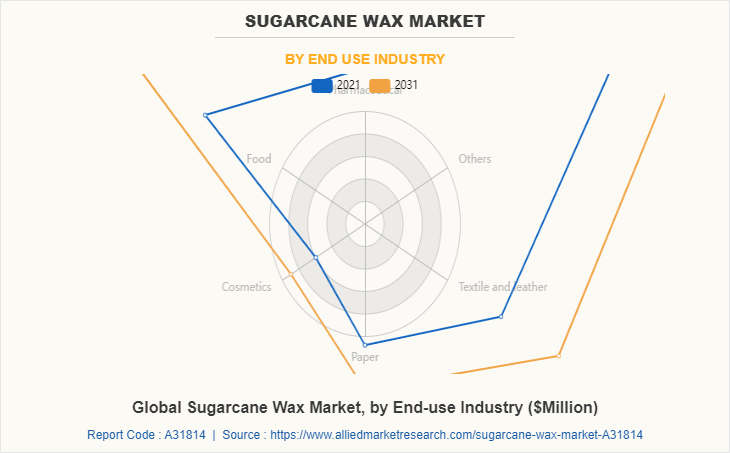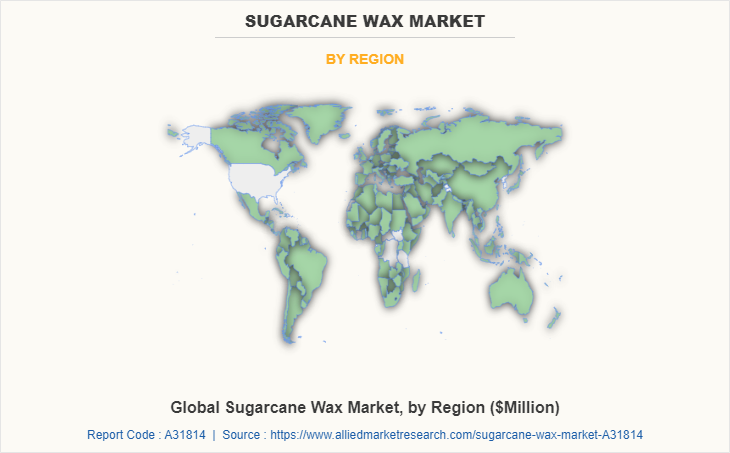Sugarcane Wax Market Research, 2031
The global sugarcane wax market was valued at $34.5 billion in 2021, and is projected to reach $48.6 billion by 2031, growing at a CAGR of 3.6% from 2022 to 2031.
Report Key Highlighters:
- The Sugarcane wax market has been analyzed in both value and volume. The value of the sugarcane wax market is analyzed in millions while the volume is analyzed in kilo tons.
- Global Sugarcane wax market is fragmented in nature with many players such as Huzhou Shengtao Biotech LLC, Cerax, Urikas, Deurex AG, Origen Chemicals, Pharma Base S.A., Azelis, Technochem Projects, Godavari Biorefieneries LTD., Sinova Development CO., LTD. Also tracked key strategies such as product launches, acquisitions, mergers, expansion etc. of various manufacturers of Sugarcane waxs.
- Included more than 20 countries in the report which covers market volume as well as market value for all the countries of sugarcane wax market.
- Covered the detailed list of manufacturers by application of sugarcane wax market. It covers the product information, application, and geographical presence of the companies.
- Conducted primary interviews with raw material suppliers, wholesalers, suppliers, and manufacturers of sugarcane wax market to understand the market trends, growth factors, pricing, and key players competitive strategies.

Sugarcane is one of the major cash crops, used for the production of sugar and ethanol. It is necessary to consider sugarcane wax when reviewing the phytochemical profile of saccharum officinarum due its widespread industrial application, and cosmetic and pharmaceutical interest. It is a potential substitute for expensive carnauba wax. The amount of wax in sugarcane ranges between 0.1 and 0.3%, depending upon its variety. Sugarcane wax is used as a commercial source of long-chain fatty alcohols, acids, esters, aldehydes, and ketones. Policosanols and D-003 along with some steroids and terpenoids have also been identified and isolated from sugarcane wax. Policosanols are a mixture of long chain primary aliphatic alcohols (1 - 8) ranging from 2.5 - 80%. Octacosanol constitutes 50 - 80% of the total policosanoles. The use of natural waxes, such sugarcane waxes, has increased in several industrial applications, including the lubrication of equipment, the polishing of metallic surfaces, the production of cosmetics, the production of food ingredients, and others. As a result, their demand has also increased.
After the sugarcane juice has been clarified, it is extracted using a solvent extraction method from the press mud or filter cake mud. Sugarcane wax is complex and variable mixture of long chain alkenes, hydrocarbons, fatty acids, ketones, aldehydes, alcohols, esters, and steroids. Sugarcane wax is indigestible and harmless to health. It is a bright yellowish color in its polished form. Sugarcane wax has a high melting point of 75 to 80 °C, which makes it stable even when exposed to sunshine.
Fruits and vegetables were either dipped in the wax emulsions or sprayed with sugarcane wax. Sugarcane wax is a by-product created during the processing of sugarcane products and appears as a thin film on the outside of the cane stalk. It is frequently used in pharmaceuticals, the processing of fruits and vegetables, chocolate products, cosmetics, and materials for polishing. For vibrant anionic emulsions, sugarcane wax offers good oil and solvent retention. Sugarcane waxes are probably the most durable waxes. They contain 100% sugar cane and, therefore, are pure natural goods. The added value of sugarcane plants increases considerably. These factors will drive the sugarcane wax market growth during the forecast period. However, the presence of alternative such as synthetics wax, mineral wax, and other natural wax, may hamper the sugarcane wax market growth during the forecast period. In addition, organic and natural cosmetics are expected to gain popularity during the forecast period, due to the rise in public awareness of the advantages of natural products. Sugarcane wax is expected to witness an increase in demand as a substitute for candelilla wax, carnauba wax, and chitosan in the edible coating of fruits and vegetables during the forecast period.
Rise in demand for sugarcane wax as a preservative in the processing of fruits and vegetables
Sugarcane wax is indigestible and harmless to health. Due to the high melting point of 75 to 80°C, it remains stable even if exposed to direct sunlight. Wax coating is used on cartons for frozen foods, butter, and margarine. Sugarcane wax offers properties such as a good oil and solvent retention for anionic bright emulsions. Emulsions made of sugarcane wax and other natural waxes were used to keep produce fresh or to give it a fresh appearance. The vegetables or fruits were immersed in the emulsions or sprayed with wax emulsions.
Sugarcane wax coatings are used to modify the internal atmosphere and to reduce water losses of fruits and vegetables. Coatings block the pores on the produce skin, reducing fruit water loss. Wax is commonly used in many fruits such citrus, tomato, bell pepper, and cucumber to improve fruit appearance and reduce transpiration; however, the effect of the wax on reducing fruit transpiration is limited (about 30% reduction). Presence of the wax coating and its composition reduces evaporation of water from the plant and helps protect it against pathogens. The physical properties of the coating and its permeability to moisture, oxygen, and carbon dioxide are important in realizing its beneficial effects. Edible coatings may contribute to extending the shelf life of fresh-cut produce by reducing moisture and solute migration, gas exchange, respiration and oxidative reaction rates, and by reducing or even suppressing physiological disorders. These factors are projected to drive the demand for sugarcane wax for preservation of fruits and vegetables.
Developments in cosmetics and personal care industry to boost sugarcane wax sales
Cosmetics and personal care is one of the major applications of sugarcane wax. Growing demand for sugarcane wax from cosmetics and personal care industry due to properties such as abrasion resistance, scratch resistance, corrosion resistance, hydrophobicity, matt look, and anti-blocking, this factor will drive the market growth during the forecast period. The usage of natural wax emulsions for organic materials in cosmetic products may also increase demand for the product during the anticipated time. Sugarcane wax is a natural ingredient that is used in cosmetic products such as potions and balms. It is used to thicken formulations. It provides stability to skincare products and cosmetics with emollient and protective qualities, and it boosts their viscosity and consistency.
Furthermore, India is a growing economy and holds great potential for future market opportunities. The usage of cosmetic and personal care products is rising in the nation as a result of the growing emphasis on beauty, an aging‐¯population, and improved quality of life. Furthermore, the demand for personal care products is also anticipated to rise throughout the forecast period due to rising awareness, changing consumption patterns and lifestyles, rising disposable income, and improved purchasing power. Moreover, an increasing popularity of organic and natural cosmetics due to the growing awareness of the benefits of natural goods is likely to drive the sugarcane wax market growth during the forecast period.
The sugarcane wax market is segmented on the basis of end-use industry and region. On the basis of end-use industry, the sugarcane wax market is segmented into pharmaceutical, food, cosmetics, taper, Textile and leather, and others. The regional market is analyzed across North America, Europe, Asia-Pacific, and LAMEA.
The major players operating in the industry include Huzhou Shengtao Biotech LLC, Cerax, Urikas, Deurex AG, Origen Chemicals, Pharma Base S.A., Azelis, Technochem ProjectsS, Godavari Biorefieneries LTD., Sinova Development CO., LTD. These players have adopted product launch, acquisition, and business expansion as their key strategies to increase their market shares.

On the basis of the end-use industry, the sugarcane wax market is segmented into pharmaceutical, food, cosmetics, taper, Textile and leather, and others. On the basis of the end-use industry, in 2021, others was the largest revenue generator and the cosmetics industry is anticipated to register the highest CAGR of 4.3% during the forecast period. The growing demand for sugarcane wax in the production of lipsticks, and other products.

Region-wise, the sugarcane wax market is analyzed across North America, Europe, Asia-Pacific, and LAMEA. Region-wise, the sugarcane wax market is analyzed across North America, Europe, Asia-Pacific, and LAMEA. The Asia-Pacific sugarcane wax market size is projected to grow at the highest CAGR of 4.0% during the forecast period owing to the growing demand for sugarcane wax in the pharmaceutical, textile and food industries in the region.
IMPACT OF COVID-19 ON THE GLOBAL SUGARCANE WAX MARKET
Asia-Pacific is the largest region for sugarcane production in the world, with Brazil being the highest-producing country. In Latin America, sugarcane makes up 50% of the production area. In India, the entire value chain of the Indian sugar industry, viz., sugarcane, sugar, molasses, ethanol and their subsequent marketing and export, has been adversely affected by the spillover impacts. The potential impacts of COVID-19 in the Asia-Pacific are focused on the reduced output of sugar due to a shortage of inputs, reduced number of workers, and restrictions on travel. Furthermore, Due to COVID-19, the regulations and the deficient number of workers led to a decline in the production of various chemicals and other industries such as cosmetics, packaging, rubber, candle, and adhesives.
Key Benefits For Stakeholders
- This report provides a quantitative analysis of the market segments, current trends, estimations, and dynamics of the sugarcane wax market analysis from 2021 to 2031 to identify the prevailing sugarcane wax market opportunities.
- The market research is offered along with information related to key drivers, restraints, and opportunities.
- Porter's five forces analysis highlights the potency of buyers and suppliers to enable stakeholders make profit-oriented business decisions and strengthen their supplier-buyer network.
- In-depth analysis of the sugarcane wax market segmentation assists to determine the prevailing market opportunities.
- Major countries in each region are mapped according to their revenue contribution to the global market.
- Market player positioning facilitates benchmarking and provides a clear understanding of the present position of the market players.
- The report includes the analysis of the regional as well as global sugarcane wax market trends, key players, market segments, application areas, and market growth strategies.
Sugarcane Wax Market Report Highlights
| Aspects | Details |
| Market Size By 2031 | USD 48.6 billion |
| Growth Rate | CAGR of 3.6% |
| Forecast period | 2021 - 2031 |
| Report Pages | 317 |
| By End Use Industry |
|
| By Region |
|
| Key Market Players | DEUREX AG, Technochem Projects, EURIKAS, Sinova Development Co., Ltd, Cerax, HUZHOU SHENGTAO BIOTECH LLC, Origen Chemicals, Azelis, Pharma Base S.A., GODAVARI BIOREFINERIES LTD. |
Analyst Review
According to CXO perspective, manufacturers of sugarcane wax invest in research and development activities to develop cost-effective and sustainable production procedures for the wax as well as to improve the recovery and refining economies, which may present opportunities for industry participants throughout the projection period. In addition, industry participants are predicted to benefit financially from the growing popularity of organic and natural cosmetics as a result of increased awareness of the advantages of natural products, during the anticipated period. Sugarcane wax is expected to witness an increase in demand as a substitute for candelilla wax, carnauba wax, and chitosan in the edible coating of fruits and vegetables during the anticipated period.
Moreover, the industry is characterized by a high number of new market entrants that are seeking to tap lucrative opportunities in the global market while existing players are entering into strategic collaborations to increase capacities & expand their reach into emerging markets. Joint venture, merger, and acquisition activities in the industry have increased significantly over the past decade
Developments in personal care and cosmetics industry
Pharmaceutical, Food, Cosmetics, Paper, Textile and Leather, Others are the end-use industries for sugarcane wax market.
Asia-Pacific is the largest regional market for Sugarcane Wax market.
The sugarcane wax market was valued at $34.5 billion in 2021, and is projected to reach $48.6 billion by 2031, growing at a CAGR of 3.6% from 2022 to 2031.
Huzhou Shengtao Biotech LLC, Cerax, Urikas, Deurex AG, Origen Chemicals, Pharma Base S.A., Azelis, Technochem ProjectsS, Godavari Biorefieneries LTD., Sinova Development CO., LTD.
The global sugarcane wax market is segmented on the basis of end-use industry and region.
Loading Table Of Content...



